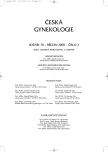The Analysis of Preliminary Spermatological Parameters in Potential Donors of Semen
Authors:
I. Oborná 1; J. Novotný 2; J. Březinová 1; M. Labanová 1; M. Svobodová 1; H. Fingerová 1
Authors‘ workplace:
Gynekologicko-porodnická klinika LF UP a FN Olomouc, přednosta prof. MUDr. M. Kudela, CSc.
1; Ústav biologie LF UP, Olomouc, přednosta prof. RNDr. K. Lenhart, DrSc.
2
Published in:
Ceska Gynekol 2005; 70(2): 104-107
Category:
Original Article
Overview
Objective:
To contribute to the contemporary discussion on the male factor infertility through the evaluation of the basic spermatological parameters in men recruiting for semen donation.
Design:
A retrospective demographic study.
Setting:
Dept. of Obstetrics and Gynaecology, Dept. of Biology, Faculty of Medicine, Palacký University, Olomouc.
Methods:
A total of 108 men aged 18 to 35 years came to the preliminary examination for the potential semen donors between January 2000 and April 2004. Spermatological analysis of the fresh ejaculates obtained by masturbation was performed according to WHO guidelines. The following parameters were evaluated: the volume of ejaculate, sperm concentration and total percent motility.
Results:
Normospermia was found in only 46 men (42.6%). Three males (2.8%) were azoospermic. The most frequent problem was asthenospermia, which was documented in 49 (46.6%) men.
Conclusion:
The analysis of the obtained data may suggest a marked semen quality decline in the Czech male population. In our opinion, further multicentric epidemiological studies concerning fertility potential in Czech male population seem highly needed.
Key words:
semen donation, semen parameters, male fertility
Labels
Paediatric gynaecology Gynaecology and obstetrics Reproduction medicineArticle was published in
Czech Gynaecology

2005 Issue 2
Most read in this issue
- Coagulation Factor VIII in the Early Postpartum Period
- Abdominal Radical Trachelectomy – Technique and Experience
- Morgagni Cyst within Tubal Lipoma
- Giant Benign Mucinous Cystadenoma of Both Ovaries in Early Puerperium: Case Report and Review of Literature
